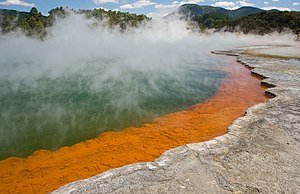Champagne pool
| Champagne pool | ||
|---|---|---|

|
||
| Champagne pool with orange sediments | ||
| Geographical location | Wai-O-Tapu , North Island , New Zealand | |
| Tributaries | Thermal spring | |
| Location close to the shore | Rotorua | |
| Data | ||
| Coordinates | 38 ° 21 '33 " S , 176 ° 22' 8" E | |
|
|
||
| length | 65 m | |
| width | 65 m | |
| volume | 50 m³ | |
| Maximum depth | 62 m | |
|
particularities |
Thermal spring |
|
The Champagne Pool m with a diameter of 65, a depth of 62 m and an estimated water volume of 50,000 m 3 one of the largest hot springs in New Zealand .
The Champagne Pool is part of the 18 km 2 large geothermal area Wai-O-Tapu , the 20 km south of Rotorua begins. The pool itself is another 7 km south and is accessible via the Wai-O-Tapu Thermal Wonderland Park . The State Highway 5 leads west past near the lake.
The 74 ° C hot water is oversaturated with the metalloid compounds orpiment (As 2 S 3 ) and stibnite (Sb 2 S 3 ), which precipitate and form an orange-colored sediment.
The name " Champagne Pool " is derived from the continuous stream of gas bubbles from which rise to the water surface, comparable gas bubbles in a champagne flute. The gas mixture that escapes consists mainly of carbon dioxide (CO 2 ), with a small proportion of nitrogen (N 2 ), methane (CH 4 ), hydrogen (H 2 ), hydrogen sulfide (H 2 S) and traces of oxygen (O 2 ).
The only known occurrence of the bacterium Venenivibrio stagnispumantis is found in the Champagne Pool .
Web links
Individual evidence
- ^ Pope, JG, Brown, KL & McConchie, DM (2005). Gold concentrations in springs at Waiotapu, New Zealand: Implications for precious metal deposition in geothermal systems. Economic Geology 100, 677-687.
- ↑ Jones, B., Renaut, RW & Rosen, MR (2001). Biogenicity of gold- and silver-bearing siliceous sinters forming in hot (75 degrees C) anaerobic spring-waters of Champagne Pool, Waiotapu, North Island, New Zealand. Journal of the Geological Society 158, 895-911.
